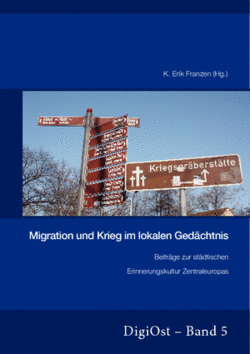
The transformation of the memory of forced migration during World War II in local contexts. Places, themes and agents in socialist industrial cities after 1989.
Project leader: K. Erik Franzen
Project term: 2013−2015
Funded by the Government Commissioner for Media and Culture (BKM), this project examines how local cultures of remembrance changed after the change of system in 1989, focussing on specific post-socialist cities.
The interrelationship of different local memories of World War II migrations is a central concern of the project. Do the memories and historical narrative of a particular ‘migrant group’, as mediated by certain social agents, dominate in the local context?
The selected Central and Eastern European industrial cities Hoyerswerda, Ústí nad Labem, Košice and Łódź were all centres of migratory movements; all have been shaped by the influx and exodus of different population groups for various reasons, including refugee movements, forced migration and labour during World War II, the deportation of Jews and other groups, expulsions and the settlement of expellees after World War II, but also economic migration, especially in the context of socialist industrialisation.
Against the backdrop of a pluralist and democratic urban society that began to emerge after 1989, where the historical (master) narratives of the state socialist era became obsolete, the project first analyses the memory agendas of local groups. Do the memories of different wartime migrations compete with each other? What is the relationship between, for example, the memories of the fate of German expellees and those of the fate of forced labourers in the cities and surrounding regions? Were these memories overshadowed by memories of mass economic migration under state socialism and an attendant spurt in urbanization?
Based on a “conception of memory as politics”, the project also examines and compares the memory hierarchies invoked by locally active agents such as local party organisations, migrant and non-migrant associations, (citizens’) initiatives, and municipal institutions, including city councils, museums, and archives. The investigation revolves around concrete discussions about what constitutes the ‘right’ memory of forced wartime migration after 1989 and further migration processes in industrial cities as a local field of action now shaped by different power resources. In this way the collective acts of remembrance conveyed by the media (commemorative events, public speeches, written documents, exhibitions) come into focus.
The interaction between remembering individuals, local civil society groups, and municipal institutions must be studied in order to describe the strategies and objectives pursued in the construction of memory in post-socialist societies beyond the social context and actual local power constellations. To what extent are ‘big’ national debates about processes of (forced) migration reflected in local contexts? Or do at least partially ‘autonomous’ forms of memory emerge in cities under investigation? A central hypothesis of this project is that post-1989 memory in the local context is dominated by specific experiences of oppression and suffering during the communist era.
The comparative project envisages four individual studies: on Hoyerswerda (K. Erik Franzen), Ústí nad Labem (Frauke Wetzel), Košice (Adam Gajdoš) and Łódź (Ulrike Lang).
K. Erik Franzen
Hoyerswerda as a melting pot? Local remembrance processes in a post-socialist industrial city since 1989.
Dr. K. Erik Franzen
In the context of the rapid industrialisation of the GDR from the 1950s onwards, the small town of Hoyerswerda grew to become the ‘second socialist city’ after Eisenhüttenstadt. The construction of the ‘Black Pump’ coal refinery combine in the district of Cottbus (foundation stone laid in 1955), the largest investment in GDR industry in the late 1950s and 1960s, promised jobs and housing. Nearby Hoyerswerda became home to the workforce of the ‘Black Pump’, eventually accommodating around 70,000 people in high-rise flats. Many of these new residents were expellees, mainly from Silesia and Czechoslovakia. The migration city of Hoyerswerda became the planned city of a political ideology. It was a ‘new space’ for ‘new people’. At the end of the Cold War the transformation of politics, industry and society in the new Germany got underway. In this context Hoyerswerda became a shrinking city. By 2011 its population had plummeted to just 36,000.
Against the background of the pluralist and democratic urban society that emerged after 1989 and in the context of historical (master) narratives from state socialist times, the project examines processes of remembering in the interaction of local agents (local branches of political parties, migrant and non-migrant organisations, (citizens’) initiatives and municipal institutions). In addition to acts of collective remembering reported on by the media (commemorative events, public speeches, written documents, exhibitions), the project focuses on negotiations of memory in the internal discussions of certain organisations.
To what extent are the ‘big’ national debates on (forced) migration and war events reflected in the local context? Can we identify even partially ‘autonomous’ forms of remembering in Hoyerswerda? What role is played by the memories of the xenophobic excesses of September 1991, which made Hoyerswerda a byword for extreme right-wing violence in the east of the Federal Republic? And how do the experiences of oppression and suffering in the communist era shape memory processes in this city? The collective memories of the ‘domovina’ (the association of the Lusatian Sorbs), which was founded in 1912 in Hoyerswerda, will also be considered in the project.
K. Erik Franzen has set up a blog on this project on the hypotheses.org platform: http://hoyerswerda.hypotheses.org/
Transformations in the politics of memory surrounding involuntary migrations in the context of World War II: Košice after 1989
Adam Gajdoš
Between 1938 and 1947 the ethnic composition of the population of Košice changed dramatically. These changes were due to a large extent to multiple waves of involuntary migrations. The town’s Czech and Slovak inhabitants fled after the First Vienna Award and the subsequent occupation of the town by the Hungarian army in the autumn of 1938; the Jewish population was deported in 1944; and Hungarians and Germans were (partially) expelled after the war. At the end of the 1940s Košice was culturally and ethnically considerably more homogeneous than on the eve of the war.
The aim of my research is to explore the existing plurality in cultures of memory surrounding involuntary migrations in the period 1938-1947 in Košice at both individual and institutional levels and to analyse how they are interrelated in the broader context of minority histories and commemorative practices in relation to World War II. Based on the accounts of witnesses and participants of the memory-keeping process and other available data, the project will attempt to retrace the evolution of memory politics over the past three decades, describing the underlying tensions and dilemmas that shaped this development. The study of recent transformations in cultures of memory involves three basic (and largely interconnected) levels of inquiry: 1) individual memories/memoirs and the family traditions of those affected by involuntary migrations; 2) cultures of memory pertaining to and administered by specific ethnic communities and their organisations; 3) the official historical narrative as reflected in municipal politics and policies, public institutions and public spaces.
The main research questions are:
How do the families affected by involuntary migrations between 1938 and 1947 remember life in or outside of Košice in this period? How is this memory passed on to younger generations?
What role have civic organisations played in shaping and promoting group-specific cultures of memory?
How have official municipal policies concerned with memory keeping, monument preservation and cultural institutions in general evolved over the past 30 years? What kind of messages do public spaces and public institutions convey?
Adam Gajdoš
Nation and class in the city's memory. On change in the culture of remembrance in Łódź since 1945.
Ulrike Lang
The systematic development of Łódź into a Central European hub of textile production was already underway in 1820. The ensuing economic growth and rapidly increasing population of the city gave rise to a mythology that presented it as the "Manchester of the East".
In 1899, Władysław Reymont's "Ziemia Obiecana" ("The Promised Land") provide Łódź with its own emblematic novel, a book which was to saddle the city with a lasting negative reputation. At the same time the beginnings of industrial Łódź were characterized by a diversification of the city's ethnic and social make-up, as Polish, German, Jewish and Russian entrepreneurs, workers and administrative classes intermingled. The Second World War, which brought German occupation and the creation of the Litzmannstadt ghetto, put an end to this diversity. Expulsions, forced resettlements and the deportation and murder of the city's Jews transformed the population mix permanently.
Interpretations of local history and the culture of remembrance in the once multi-ethnic industrial city of Łódź after 1945 were guided by overarching ideas of nation and class, which always interacted in a specific, yet ever-changing, relationship to one another. During the time of the People's Republic, Łódź's pre-war multi-ethnic past was either ignored or presented hand in hand with Marxist ideas on class tensions, underlining its relevance in the creation of national antagonisms. 1989 brought with it both a renewed interest in the multicultural heritage of the city and a new appreciation of the "civic values of the entrepreneur". Recent years have seen the development of a more positive local identity, involving a harking back to the (perhaps rose-tinted) image of a tolerant, multicultural, capitalist society at the turn of 19th to 20th Century, a vision that has since become integrated into Łódź's image of itself and into the city's marketing.
This dissertation attempts to analyze the changing view of nationality and class since 1945 using a number of sample realms of memory in the mnemotopos of Łódź. On the one hand, mnemotopoi through which changes in remembrance patterns come into focus – national uniformity vs. ethnic diversity; class struggle and revolution vs. tolerance and community; social pauperization vs. private charity; "the masses" vs. the individual; the dignity of the worker vs. entrepreneurship – on the other, realms of memory can be seen as intersections between local, national, and global discourses and interests in relation to remembrance.
For this reason, both public and private sector bearers of memory both within and outside the city are also looked at in the study. Beyond the local context, therefore, the project also aims to provide insights into processes of inter-ethnic and institutional transmission of collective memory.
Ulrike Lang
Memory in the local context – the example of Ústí nad Labem after 1945.
Frauke Wetzel
This project is concerned with the Czech (re-)appropriation of the Bohemian borderlands (pohraničí) from 1945 to the present and representations thereof. It focuses on the construction of local, regional and national identities. This process, which began with the post-war reincorporation of the Czechoslovak borderlands ceded to Germany in 1938, is examined in a case study of the Northern Bohemian town of Ústí nad Labem. At the end of the war the majority of the town’s German-speaking population was expelled. This meant that of the town’s post-war population, only one quarter had lived there before the end of the war. New residents had to be lured to the border town and returned from more central-lying regions. The project analyses the reinterpretation of the local and regional past in narratives, symbols, cultural institutions and other representations of history and in memory politics, paying particular attention to the tension between official guidelines and their implementation and everyday adaptation at local level.
Frauke Wetzel
Events
- International workshop: "The Transformation of Memory after 1945. City, Migration and Memory in a European Comparison" (14.-15.10.2013, Košice) Program; Conference report
- International conference: ""Isolated or Entangled Histories? Migration erinnern in regionalen und lokalen Kontexten“ (3.-5.12.2015, Ústí nad Labem) Program; Conference report
- International talk series: "Who Owns Memory? Migration and Regional Commemoration" (December 2015 - February 2016, Łódź - Ústí nad Labem - Hoyerswerda - Košice) Program
Publication
Migration und Krieg im lokalen Gedächtnis. Beiträge zur städtischen Erinnerungskultur Zentraleuropas.

